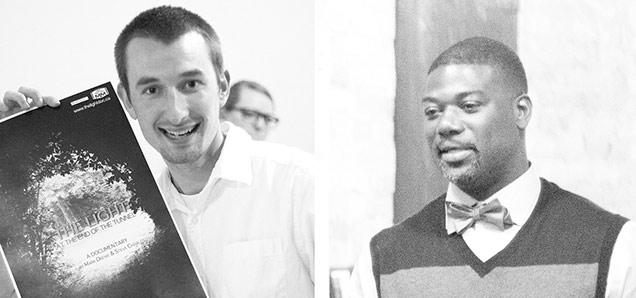Local duo to shed Light on London's multicoloured history
 CREDIT: CHRISTAL CHEUNG
CREDIT: CHRISTAL CHEUNG(Left) Mark Drewe and (right) Steve Charles held a fundraising event called Corks & Kegs to inform guests about the project and to raise funds for the documentary as well as the African Methodist Episcopal Church.
Who would have thought that the move of the Fugitive Slave Chapel would unearth stories about multiculturalism and Black history here in London?
Steve Charles, London native and draftsman, saw an ad in the paper about the church's move and offered up his services to help move the building.
The move got Charles thinking it would be a great documentary topic, so he contacted his friend Mark Drewe, a Western University film studies graduate, to lend him a hand.
“We started exploring that idea,” said Drewe. “The more we explored about the documentary side of that, we found out this whole world of stories that are local and historically significant in the times that were happening,”
They found that fugitive slaves from the States played a hand in bringing the idea of multiculturalism to the city and the country.
“As we learned about the rich history of London, I thought it's just an awesome story that needed to be told,” said Charles. “It just shows insight and a little bit of pride for the city.”
So off they went, scouring the city for stories. With some help from an archivist from the Catholic Diocese and Joe O'Neil of O'Neil Funeral Home, Charles and Drewe were well on their way.
“In the course of that, we found eight or nine fantastic stories of human accomplishment in the London area,” said Charles. “We're going to highlight four of the best stories and that's what our documentary is going to be.”
One that stood out to them both was the story of a boiler explosion and a black man named Daniel Sullivan.
Sullivan was working as a boiler technician in a local leather tannery in 1873 — a year after the owners and lead engineer were told that the boiler needed to be replaced.
On April 18, 1873, the boiler — in a state of disrepair — was about to explode.
“He went in and he knew the boiler was going to explode,” said Drewe. “But he did what he did to give them more time so other people could escape before the actual explosion.”
Sullivan and two others died as a result.
“It's real. It actually did happen,” said Drewe. “London has that anonymous feel to it sometimes, and this story, the action that he did, ended up making international news. It was in papers in the U.K. and in New York.”
“It was a moment of almost truest heroism and it goes to show the character this person was,” said Drewe. “That really helped to build that sense of community that showed even though this wasn't somebody from Canada ... he also gave his life to save other people in the country here.”
Charles hopes the documentary will show viewers the history of how blacks and whites interacted during a “volatile time when it came to race.”
“[We were] a pretty trend-setting society at the time,” said Charles. “We should be proud of what our ancestors did, which enabled us to live the lives we live now.”
For Drewe, this could be an opportunity to squash London's feeling of anonymity.
“What I think we're trying to do with this documentary is to remind people there are a lot of reasons to be proud of this city because it is significant, and we should remember the people that were so important in not only building their own life, but also contributing to the identity of Canada,” said Drewe. “London seems to be very central in the development of [multiculturalism] ideas as well that we just now take for granted.”
The duo named the documentary The Light at the End of the Tunnel.
“If you look at the Underground Railroad ... they travelled at night, and it was horrible ordeal that they went through for their travelling,” said Charles. “When they got to Canada, they were free and it was like the light at the end of the tunnel.”
“The light refers to the idea of religion, which is central in the founding of London as well,” said Drewe. Something perfectly mirrored in the moving of the Chapel.
What started as a documentation of the move of the Fugitive Slave Chapel grew into something much more.
“It was a better story,” said Charles. “It was one that I would rather hear if I had to tell my kids a bedtime story, I would tell that than just the moving of a building.”
“We want people to come back to this documentary and remember these stories,” said Drewe. “And remember these people, and almost bring them back to life in a way, through the actions that they did.”
Charles and Drewe hope to finish the documentary by the end of next year.
For more information, check out thelightdoc.ca or follow them on Twitter @TheLightDoc.













